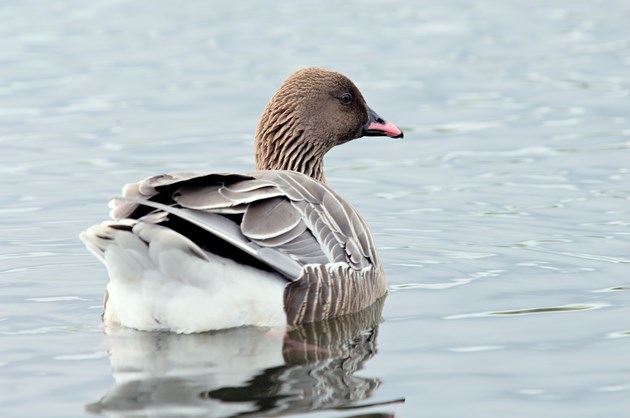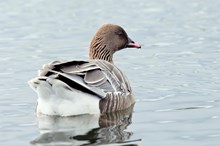29 November, 2022
Public asked for help as Moray avian flu cases increase

NatureScot is asking members of the public and goose shooters to avoid Findhorn Bay in Moray as much as possible after reports of more than 22 dead pink-footed geese and an unusual number of gulls in the area.
Wildfowlers and recreational shooters are being asked not to shoot around the bay and surrounding feeding fields. Walkers and others are also asked to avoid the bay to minimise the possible impact of avian flu on wild birds.
NatureScot is awaiting test results to confirm if the deaths are due to avian flu. In the meantime, the nature agency has agreed a call for voluntary restraint with Moray Council as a precautionary measure.
Alastair MacGugan, NatureScot’s Wildlife Management Manager, said: “We are very concerned about the impact of avian flu on our wild bird populations, particularly with these latest suspected cases in Moray. It’s crucial we respond to the evolving situation quickly to reduce the chances of the disease spreading further and faster in Scotland.
“We don’t think a blanket ban on shooting geese across the Moray coast is warranted. But given what seem to be increasing cases of avian flu in the area, we would ask shooters to exercise restraint at this point until we find out more. We are also grateful to members of the public for their assistance in avoiding the area to help prevent the spread.”
Colin Bell, Environmental Protection Manager for Moray Council, said: “While there is little risk to human health from the virus, it is one to take seriously as we see bird populations impacted considerably, so we’re grateful to all members of the public who continue to exercise caution around sick or dead birds in Moray. The same appreciation goes to wildfowlers who are able to refrain from activity in and around Findhorn Bay at this time.”
NatureScot has a surveillance network monitoring migrating geese and wintering waterbirds to guard against the continuing threat of avian flu this winter. Information gathered by a team of site managers and volunteers across the country is feeding into the work of Scotland’s avian flu task force, helping it provide swift advice to government, conservationists and land managers on practical actions to help reduce the transmission and impact of the virus.
Migratory birds, especially waterbirds, carry different strains of the virus along their migration routes. Last winter, there was a large outbreak in Svalbard barnacle geese around the Solway, with approximately a third of that population impacted. Other goose species such as pink-footed geese were not impacted as heavily.
This past summer, the current H5N1 strain had a devastating impact on seabird populations. Now that the seabird breeding season is over and colonies have dispersed, concerns remain about how the outbreak could evolve over the coming months and affect migrating goose populations, other waterfowl and waders.
Highly pathogenic avian influenza (HPAI) H5N1 has been confirmed in a number of domestic poultry premises around Banff and Turriff where restrictions and prevention measures are in place. Earlier this month, the chief veterinary officers from Scotland, England and Wales declared an Avian Influenza Prevention Zone (AIPZ) across Great Britain to mitigate the risk of the disease spreading among poultry and other captive birds.
Scotland’s avian flu task force is overseeing the development and implementation of the upcoming Scottish Avian Influenza Response Plan which will inform management responses, assure the best monitoring and surveillance and support mitigation and recovery.
Fortunately, the risk to human health from the virus is very low, but members of the public should continue to avoid touching sick or dead wild birds and keep dogs on the lead in areas where there are infected birds.
Contact information
- Name
- NatureScot Media
- Telephone
- 0131 316 2655
- media@nature.scot
Notes to editors
The NatureScot Scientific Sub Group, established earlier this year, is considering the extent to which different activities may disturb birds, leading to increased infection and slower recovery rates. A precautionary approach is being taken to any activity that may individually or cumulatively impact on geese and wintering waterbirds – including public access, cockling, ringing, licensed shooting and wildfowling.
NatureScot is Scotland's nature agency. We work to enhance our natural environment in Scotland and inspire everyone to care more about it. Our priority is a nature-rich future for Scotland and an effective response to the climate emergency. For more information, visit our website at www.nature.scot or follow us on X at https://x.com/NatureScot
’S e NatureScot buidheann nàdair na h-Alba. Bidh sinn a’ neartachadh àrainneachd na h-Alba agus a’ brosnachadh dhaoine gu barrachd suim a chur ann an nàdar. Tha e mar phrìomhachas againn gum bi nàdar na h-Alba beairteach agus gun dèilig sinn gu h-èifeachdach le èiginn na gnàth-shìde. Tha an tuilleadh fiosrachaidh aig www.nature.scot no air X aig https://x.com/NatureScot

